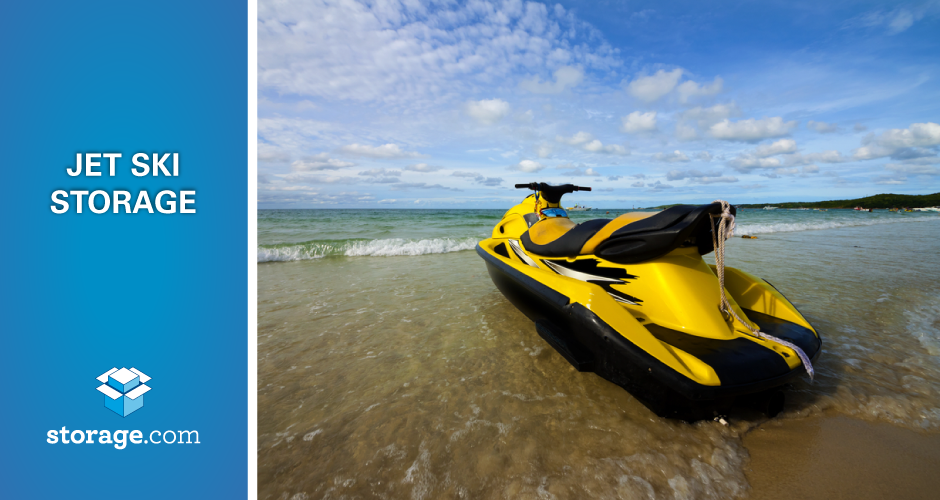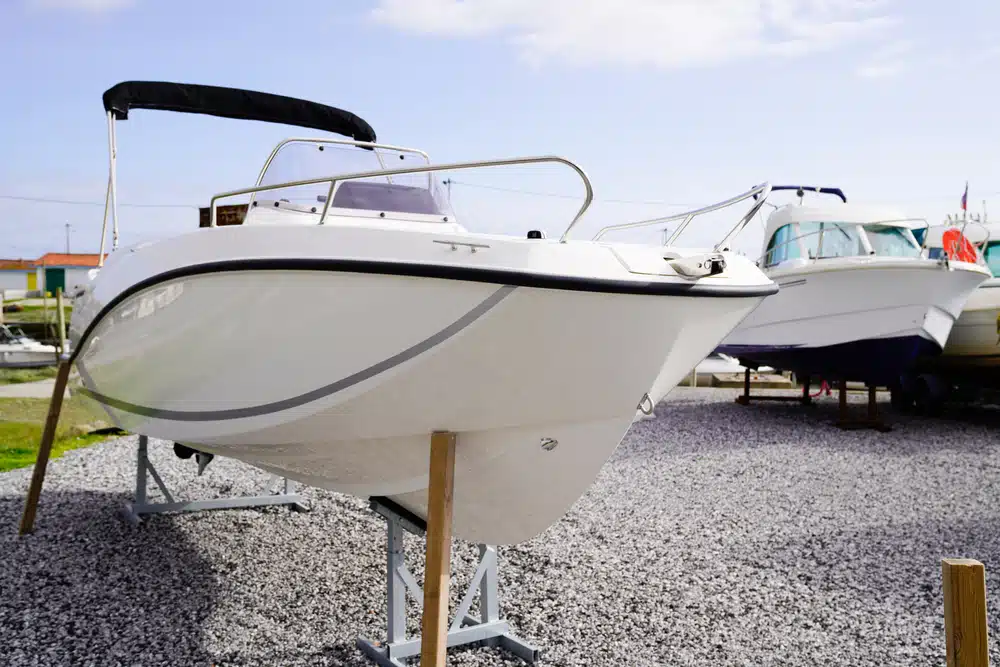
Boat owners lead a busy life.
You spend your free time towing your boat to your favorite lake or ocean and trailering it up the boat ramp when you’re done.
When your boat isn’t in use, you’ll need to prep it for storage and find a place that provides secure and reliable boat storage until the weather clears up and you get some more free time.
But you can’t just put your boat in storage anywhere. Keeping it in water risks weather-related damage or rusting. And keeping your boat in outdoor storage at home, either in your driveway or garage, takes up valuable extra storage space.
Plus, not all neighborhoods allow outdoor vehicle storage for boats, campers, or RVs in residential driveways. You may have to build a custom shelter for covered boat storage. Or you can take the easy way out and rent a boat storage space at a commercial storage facility.
Whether you’re looking for indoor boat storage or at-home boat storage, this article is for you.
We’ll cover the different types of boat storage, boat storage ideas, and how to find boat storage near you. We’ll also discuss how to winterize a boat for storage and the basic boat maintenance upkeep to conduct during long-term storage.
Preparing Your Boat for Boat Storage
Prepping your boat for storage isn’t a one-size-fits-all endeavor — it changes with the seasons and where you are. If you’re up north or somewhere chilly with brutal winter months, you’ll want to winterize your boat to handle the freezing temps.
But no matter the climate, long-term boat storage prep starts the same way: with the owner giving their vessel a good cleaning and a thorough inspection, fixing any issues you find.
Boat Cleaning and Inspection
Time to get your boat ready for a little downtime!
- Give the whole boat a good wash to eliminate salt, dirt, and all that gunk.
- Post-wash, make sure every nook and cranny is dry. Extra attention on the bilges and any other spots water might want to hide will help keep mold and mildew at bay.
- For premium protection, add a layer of wax intended for boats.
- Inspect the hull for any signs of trouble like cracks or blisters — better to catch them now than on your next adventure.
- Check the propeller for nicks or dents and clear out any tangled fishing line that might mess with your boat’s groove.
- Check that your electronics are functional, and if you’re not storing the boat at home, strip it of any valuables or gear that shouldn’t sit there during long-term boat storage.
How to Store a Boat in Winter: Boat Winterization Checklist
When it’s time to cozy up your boat for the cold months, remember that every boat model is slightly different.
We suggest consulting your owner’s manual before prepping your boat for winter storage, changing the oil, or flushing the engine. Let’s break this process down into interior and exterior boat preparation.
Prepping the Interior of Your Boat for Storage
With the manual by your side, you can work your way down this boat winterization checklist:
- Prepping your boat for winter storage starts with filling the fuel tank and adding a fuel stabilizer to prevent any condensation and separation.
- Drain the boat, engine, and all lines of water. Then, flush the engine block with a high-quality, non-toxic marine antifreeze.
- Check the drive oil, engine oil, fluids in the lower gear shaft, and all other fluids for any remaining water that could expand over the winter.
- If applicable, winterize all freshwater and wastewater holding tanks, as well as generators and air conditioning systems.
- If you lack the time or workspace to properly prepare your boat for winter storage on your own, check your local listings for a trusted boat winterization service company in your area.
Prepping the Exterior of Your Boat for Storage
Prepping the inside of your boat for winter storage is just as vital as getting the outside ready. Interior boat prep includes proper ventilation techniques, moisture absorbers, cleaning, and protective covers.
- Keep air vents open and, if possible, slightly open a window or hatch to promote circulation and ward off dampness.
- Tuck tiny silica gel packs in drawers, cabinets, and other enclosed spaces.
- Vacuum carpets, wipe down surfaces, and clean all upholstery.
- Once everything is perfectly dry, use multiple protective covers. Be sure the cover fits over your boat furniture and electrical equipment, guarding against dust and moisture.
Boat Storage Ideas: Different Types of Boat Storage
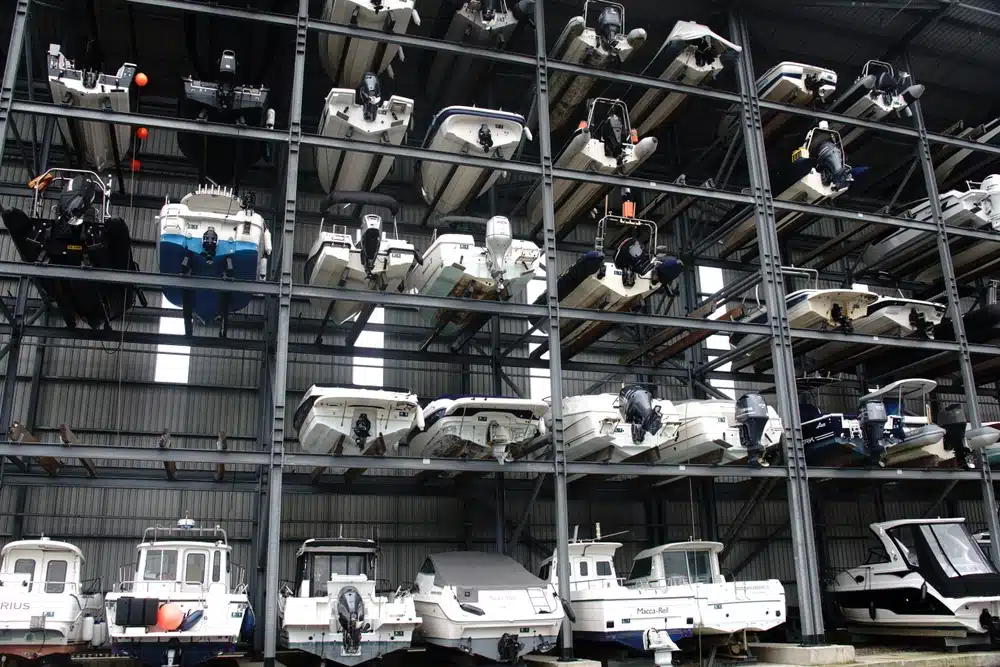
Whether you’re storing your boat at home (in a garage or shed), at a storage facility with extra security or simply prefer the great outdoors, each option has its merits, so weigh them based on your needs, budget and convenience to find the perfect winter home for your boat.
At-home boat storage
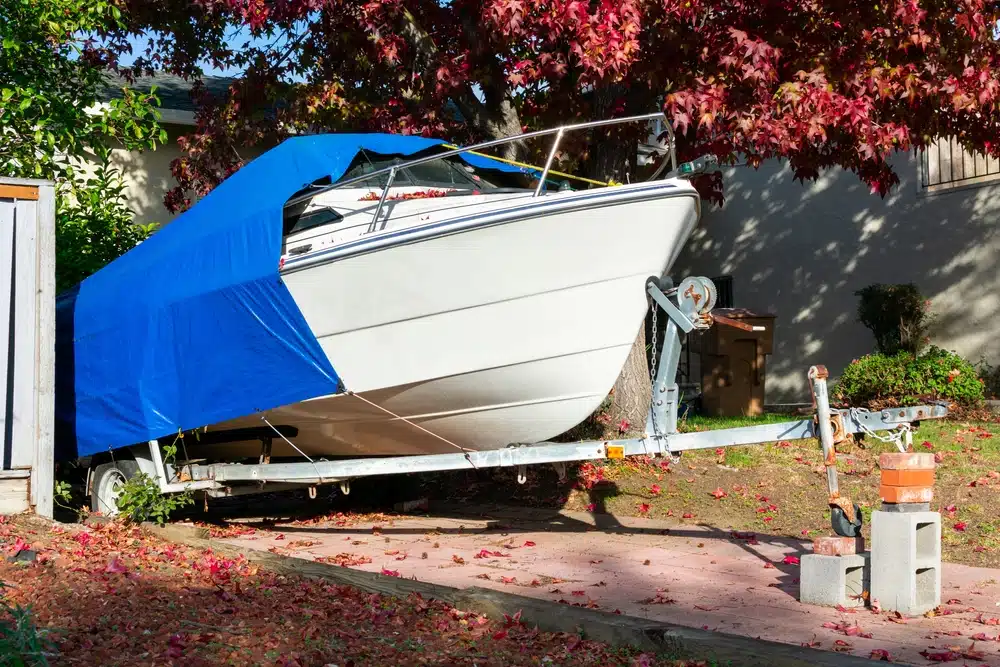
If your boat fits and you don’t have other vehicles that need to get in and out, the garage is a great place to store it away from the elements. A quick note, though: Make sure there’s enough room to walk around for easy access and maintenance — measure twice and park once!
No garage space? Build or buy a custom shelter. A simple canopy or a more robust boat house can shield your vessel from weather woes.
Outdoor boat storage
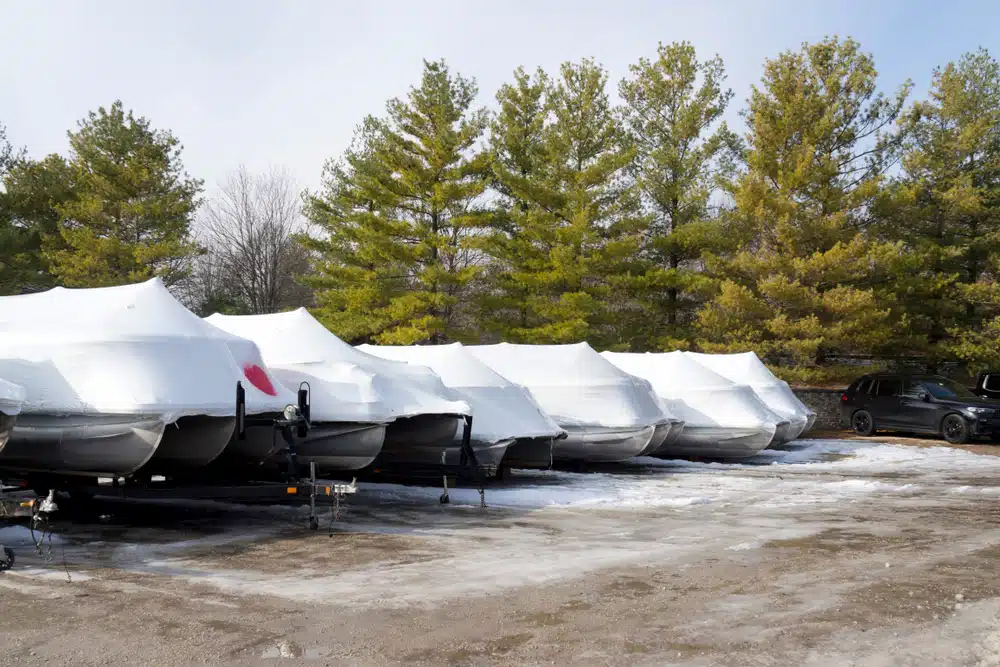
Cover and ground are the keys to successful outdoor boat storage. When going the route of outdoor storage, we recommend looking for a high-quality boat cover and choosing a spot with good drainage to avoid pooling water.
The best boat covers are tough enough to handle the weather in your area — whether it’s UV rays, rain, or snow.
You can also research a boat storage box that fits your boat. A boat storage box is similar to a tarp, but instead of hefty canvas, it’s made from solid material that offers premium protection. That said, these boxes are more expensive.
To lower your outdoor covered boat storage cost, try tying a plastic tarp to the boat, jack stands, or cradle. A tarp prevents mildew because it provides airflow and ventilation. However, tarp ties could cause chafing, and this method will only last through one off-season. Gravel or paving stones can prevent sinking and stabilize the boat while keeping it mud-free.
Pro tip: Use tie-downs to anchor your boat to the ground. They prevent it from tipping over or shifting during strong winds.
How To Find The Best Boat Storage Facilities Near Me
You can use our handy storage.com search tool to find a storage unit that offers exactly what you need, be it facilities with security cameras, climate control, or 24/7 access drive-through storage facilities.
Many commercial storage facilities out there offer indoor, outdoor, and covered storage spaces for boats. Specialized ones also have dry storage options that use a forklift to store boats on specialized racks that maximize space.
Indoor boat storage units cost more but offer the best protection from the elements. That said, the most affordable boat storage facilities are those offering outdoor boat storage.
Covered storage provides a popular middle ground, and cost-effectiveness may be the biggest of all dry stack storage benefits.
Looking at indoor options and not sure about the unit size you need? The smallest boats can easily fit in a 10’x15’ unit — if you have a larger model, go for a 10’x20’ or even a 10’x30’ unit just to be sure.
For ultimate protection, opt for a climate-controlled unit. Since it regulates temperature and humidity, this is your best bet for sensitive finishes and electronics. Also, choose a facility with enhanced self-storage security measures like gated access, surveillance cameras, and on-site staff to keep an extra eye on things.
Pro tip: Some facilities offer additional perks like boat maintenance services or battery charging stations, a real boon during the off-season.
Boat Storage Maintenance
While your boat’s parked for the off-season, a little vigilance goes a long way:
- Regularly inspect your boat cover for any tears or weaknesses.
- Set traps inside and around your boat to catch any sneaky critters looking for a winter home.
- Moisture control in boat storage should be a top priority, so keep an eye out for any signs of moisture or mold build-up in closed areas.
- Disconnect the battery, charge it fully, and store it safely on a wooden surface at home. Hook up a trickle charger to keep the battery fresh without overdoing it.
- Periodically check the battery for corrosion or other signs of wear and deal with problems as soon as they pop up.
Security and Legal Considerations of Boat Storage
Whether storing a boat at home or in a storage facility, the first line of defense among all boat storage security measures consists of a sturdy lock and a loud alarm.
If you’re storing your boat outside, ensure it’s under some bright lights and install some cameras around it. Well-lit areas are key in preventing boat theft, and cameras give you eyes on it when you’re not there.
Now, security isn’t everything to consider — you must also comply with local laws. The thing is, some places have rules about where and how you can store a boat, and a quick check with local authorities or your HOA can save you from fines.
Insurance matters, too. Call your agent to confirm you’re covered for long-term boat storage, especially if you change storage spots.
Boat Storage Cost
From basic outdoor spots to fancy indoor shelters, choosing the right storage can impact your wallet, as storage costs can vary like the ocean waves.
As we mentioned before, outdoor spaces are cheaper but offer less protection. Indoor storage (especially if climate-controlled) costs more but keeps your boat cozy and safe from theft, vandalism, and the elements.
Size matters, too. Bigger boats need bigger spaces, which can mean bigger bills. Measure your boat to ensure you’re not paying for more space than you need, but leave enough room around it to perform maintenance easily.
Pro tip: Handling some tasks yourself, like winterizing your boat, can reduce costs at facilities that charge for extra services.
How Storage.com Can Help Find Cheap Boat Storage
Ready to dock your boat in the perfect spot? Consider what it needs, what your budget allows, and how the seasons affect your region. When you bought it, your boat probably cost you a good chunk of change, so don’t let it rust, grow mold, have chipped paint, or get cracked seat cushions.
Storing a boat at home or at a facility, winterizing it, securing it, and finding the best boat covers may seem like a hassle upfront, but it will protect your boat when you’re not using it. With the right plan, you can sail smoothly into long-term boat storage without a worry.
But how do you find the perfect boat storage facility? Are there features that are important to you, like climate control or advanced security measures? How about limiting your search results to drive-up storage units? Or maybe you want to search by location, isolating storage facilities that are halfway between your house and your favorite boating spot?
Good news, thanks to storage.com, you don’t have to choose.
Take the first step toward finding the ideal storage unit size for a boat in your neck of the woods by measuring the boat of other personal water craft you need to store. Measure the length first. Then, measure the width and add enough extra space to get in and out and walk around the boat for routine maintenance.
Enter your zip code into our storage.com boat storage search feature to find the best deal on a dedicated vehicle storage space near you.
Check the boat storage sizes the facility has available, and look for something that gives you ample space for both your vehicle and you to move around it. Consider whether or not you’re only storing your boat or if you’ll also be storing additional items alongside your vehicle.
We also suggest establishing which amenities you need before you start shopping for vehicle storage. Browse the options based around your area and look for offerings like long-term boat storage, short-term boat storage, climate-controlled indoor parking spaces, covered parking spaces, etc.
Storage.com gives you access to the largest marketplace for storage facilities of all types, and our storage search tool makes finding storage units big enough for a boat as easy as entering your zip code, filtering the options, and scrolling the results until you find exactly what you need.
FAQs
What is the cheapest way to store a boat?
The cheapest boat storage option is outdoor storage at home using a quality boat cover and proper drainage setup. If home storage isn’t possible, an outdoor spot at a storage facility is the next most economical choice. Covered storage provides a popular middle ground.
How much does it cost to store a boat per year?
Boat storage costs $20-50 per foot annually for outdoor storage and $50-200 per foot for indoor storage. Based on these calculations, a 20-foot boat would cost $400-1,000 per year outdoors or $1,000-4,000 per year indoors.
Should I store my boat with a full tank?
Fill your boat’s gas tank and add stabilizer before storage to minimize air exposure. Air can enter the empty space in your fuel tank and cause corrosion to the tank walls, fuel deterioration, and the formation of gum and varnish that can clog fuel lines.
Is it OK to store a boat outside?
Storing a boat outside requires precautions and routine maintenance. Use a high-quality cover and choose a spot that allows drainage, minimizing moisture exposure. In high-humidity areas, be vigilant about mold and mildew growth and protect against UV damage to prevent fading and deterioration.


